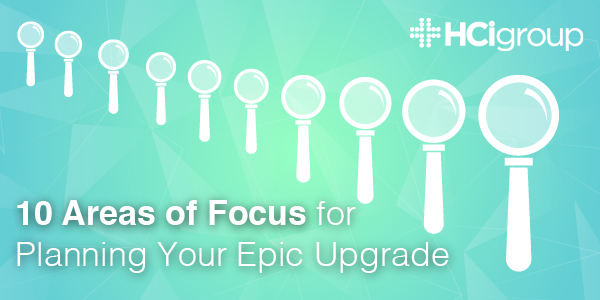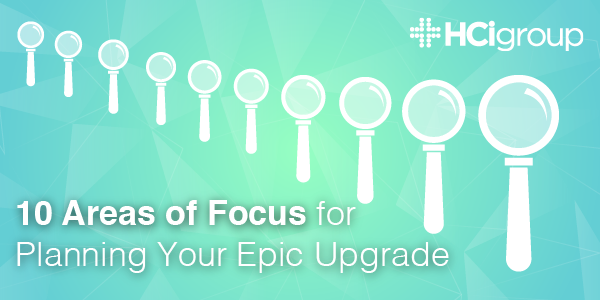10 Areas of Focus for Planning Your Epic Upgrade


When the time comes for your Epic upgrade, proper planning and execution is imperative to your success. In this post, we've compiled a list of 10 areas of focus for you to consider with planning for your Epic upgrade.
1. Plan Well Ahead
Set a target date for your next version Epic upgrade as soon as possible. Even if your organization takes a conservative approach, and times the upgrade several months after the Epic release, get your upgrade on the calendar as soon as Epic releases a new version. Keep it simple and just take a few minutes to set a target date and then mark it on your organization’s long-range IT timeline. By doing this, your PMO and others will avoid scheduling major projects over your upgrade.
2. Comprehensive Project Plan
Develop a comprehensive project plan with key milestones, including release note review, build & unit testing, integrated testing and upgrade rehearsals. Start from your upgrade date and work backwards to develop a complete timeline. Share this high-level plan and timeline with IT and operational resources to properly vet your timeline.
3. Allow Ample Time for Note Review
Depending on the availability of resources, you need to plan for 1-2 months of release note review in Epic’s Nova system. This is needed to develop a team by team list of all build, training, and testing tasks. Epic does not deliver this specific list because each customer is different and an initial screening process is required.
4. Engage Operational Stakeholders
Engage operational stakeholders early and often throughout the upgrade process to ensure a smooth transition to the new version and adoption of enhancements. Schedule rounds of new feature validation, user acceptance testing, provide & distribute comprehensive training content and capture feedback to ensure that the new version is optimized to meet your organization’s needs.
5. Understand the Epic Upgrade Process
Understand the technical underpinnings of Epic’s traditional and transparent upgrade processes; use that knowledge to develop a detailed plan for each environment upgrade. Transparently develop and communicate those plans across both your Epic application teams and technical services to ensure that all resources are engaged and have buy-in on the schedule.
6. Limit and Account for "Version Skew"
Once you upgrade the first production stream environment, which most systems name POC, you will enter a period of version skew. During this time, your build and test environments are on the new version, while production is on the old version. Limit this amount of time as much as possible by using a release environment outside of your production stream for release note review. Once version skew is in place, additional work is required of your application teams every time they send a change into production. Packages with skew errors must be tracked and re-sent to PRD after the upgrade.
7. Develop a Training Strategy
Think outside the box when addressing upgrade training needs in order to provide the most bang for your buck. Do not pull clinicians and support staff into costly classroom training sessions if you do not need to. Utilize technology and detailed training plans to deliver meaningful, easily accessible upgrade training materials to the end user community.
8. Detailed Minute-by-Minute Plan
Develop a detailed minute-by-minute plan of the upgrade to the production environment and ensure communication and management of downtime. Run two transparent upgrade dress rehearsals to fine-tune the plan and accurately forecast the length of your planned downtime. Communicate this projection to your hospitals and ensure that they are adequately staffed to support the downtime.
9. Plan for a Command Center
While an upgrade is not as large as an Epic implementation go-live, do not underestimate its impact to the user community and patients. The upgrade should be supported similarly to an implementation go-live with a 24-hour command center. Staffing levels do not need to be as high as an implementation and can be tapered off once the new version is stabilized. They key is to ensure adequate coverage across all applications and put the same processes in place as you would for a full Epic implementation go-live.
10. Epic Optimization
Consider post-upgrade optimization throughout the planning and execution of the upgrade. Direct application teams to identify Epic enhancements during the review process that will be implemented weeks to months after the upgrade. Identify additional optimizations during end user acceptance testing and go live support. Once the upgrade is stabilized, turn your attention to executing the optimization plan and soon it will be time to start your next upgrade!
Additional Resources (follow these links):
- Epic Upgrade Services
- Epic Upgrades: 3 Considerations When Deciding Between a Single or Double Upgrade
- Epic Upgrades: Key Strategies and Cost Considerations (Podcast)
- 8 Essential Factors for a Successful Epic EHR Upgrade
Whether your organization is planning for an Epic upgrade or is currently in the process of upgrading, The HCI Group has the resources and expertise to help make it successful.
The HCI Group works closely with your team to identify your needs, assess your readiness and plan for your upgrade. If you are interested in discussing Epic upgrades in more detail, contact The HCI Group today.

